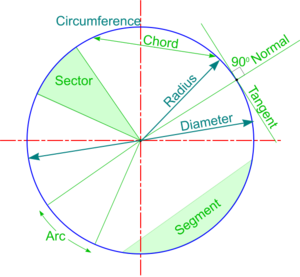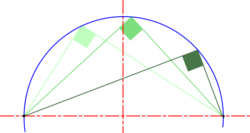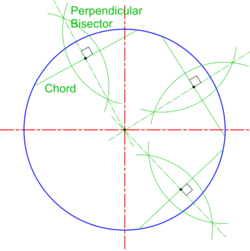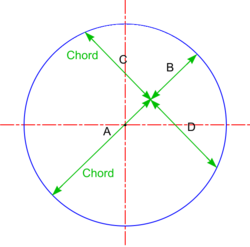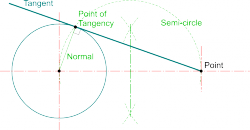Circles are very familiar but have associated with them terminology, properties and characteristics with which all involved with design and technology should understand.
A particular property of a circle is that its radius can be stepped off around its circumference exactly 6 times. This is effectively constructing 6 equi-lateral triangles, the interior angles of which are all 600, and the sum of all angles at the centre of any polygon must equal 3600.
The sides of these equi-lateral triangles become chords of the circle and should not be confused with the length of an arc, which is longer. Lengths of arcs can be found by dividing the circumference by the number of sides. The circumference is calculated as 2πr or πD (π is a constant obtained by dividing circumference by diameter - i.e. approximately 3.142)".
| Angle in a Semi-Circle
|
- Any angle drawn within a semi-circle is a right angle.
Note:
If angles are drawn in each half of the circle the result would be a particular case of cyclic quadlitaleral which makes it easier to see the more general case that the sum of opposite internal angles of any cyclic quadlitaleral is always equal to 1800.
|
|
| Bisecting Chords
|
- The perpendicular bisectors of any two chords to a circle will intersect at the centre of that circle
- In practice, a 3rd chord is also bisected as shown to serve as an accuracy check when finding the circle centre.
|
|
| Intersecting Chords Theorem
|
- Where: W is the length of the chord defining the base of the arc and H is the height measured at the midpoint of the arc's base.
- This is a particular case of the Intersecting Chords Theorem which states that this relationship (A x B = C x D) is true for any two intesecting chords, whether or not one of them is a diameter
|
|
| Tangent from a Point Outside a Circle
|
- For most practical purposes, especially with large-scale work, it can be satisfactory simply to draw a line touching a circle as the tangent
- There may be occasions however when it is important to know exactly where the tangent touches the circle circumference (i.e. the Point of Tangency]]
- For points on the circumference, the tangent is simply drawn as a line at right angles to a line joining the point to the circle centre (i.e. the Normal).
- Points outside the circumference exploit the property of Angles in a Semi-Circle as described above.
- Join the point to the circle centre and construct a semi-circle on this line.
- Where the semi-circle cuts the circumference provides the Point of Tangency to which may be drawn both the Normal and Tangent required.
|
|
